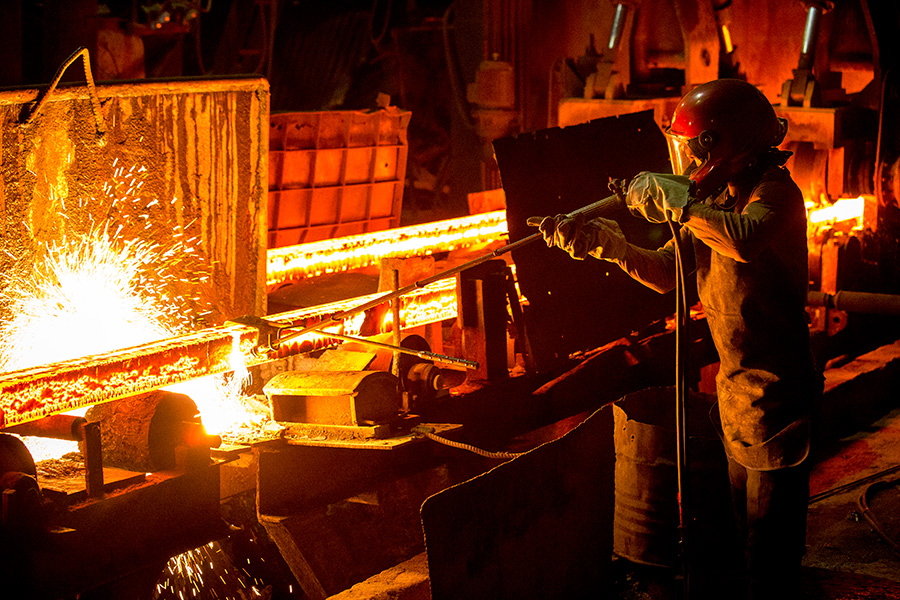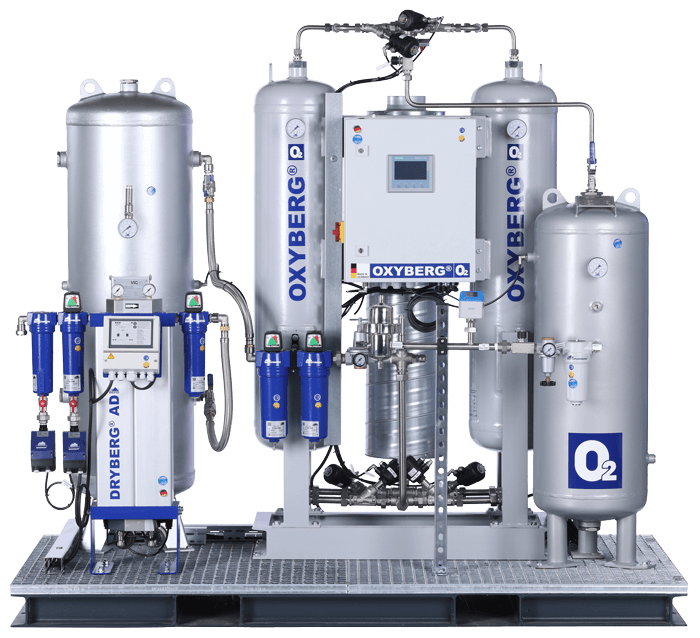
Industrial Oxygen Generators for Steel Mills and the Metal Industry
An industrial oxygen generator is indispensable in steel mills and the broader metal industry, where a consistent and high-purity oxygen supply is critical for operations such as cutting, welding, and steel production.
Utilizing Pressure Swing Adsorption (PSA) technology, these generators efficiently separate oxygen from compressed air, delivering oxygen with purity levels up to 95% .
This method not only ensures a reliable oxygen source but also offers cost-effective and energy-efficient solutions, making it a preferred choice for industries demanding uninterrupted oxygen availability .
Key Features of Oxygen Generators
PSA Technology
At the core of our oxygen generators is psa technology. This method utilizes a zeolite molecular sieve to selectively adsorb nitrogen and other gases from ambient air, allowing only oxygen to pass through. The result is a stream of high purity oxygen, ready for industrial use.
High Purity Oxygen
Our generators produce oxygen with a purity level that meets the stringent requirements of various industries. Whether you need oxygen for metal cutting, welding, or medical applications, our generators ensure you get the purest oxygen possible.
Cost-Effective Solutions
By generating oxygen onsite, industries can significantly reduce their reliance on external oxygen supplies, leading to substantial cost savings. The efficiency of PSA also means that operating costs are kept to a minimum.
Versatility and Applications
Our oxygen generators are designed to cater to a wide range of applications. From metal processing and water treatment to fish farming and healthcare, these generators provide a reliable oxygen supply tailored to specific industrial needs.

Advantages of our Onsite Oxygen Generators
- Cost Efficiency: Generating oxygen onsite significantly reduces expenses related to purchasing, transporting, and storing oxygen cylinders or liquid oxygen. It eliminates costs associated with cylinder refills, equipment rental, and delivery, resulting in substantial long-term savings.
- Enhanced Safety: Onsite oxygen generation minimizes the safety risks linked to handling and storing high-pressure gas cylinders. By reducing the likelihood of leaks, accidents, and fire hazards, it offers a safer alternative for industrial environments.
- Reliable and Continuous Supply: Oxygen generators ensure a steady and uninterrupted oxygen supply, eliminating downtime caused by cylinder depletion or delivery delays. This is particularly vital for industries with 24/7 operational demands.
- Customizable Oxygen Purity and Flow: Modern systems, such as those from BERG GaseTech GmbH, offer flexibility in oxygen purity and flow rate, allowing adaptation to specific industry requirements and varying process needs.
- Environmental Sustainability: By eliminating the need for transport and frequent deliveries, onsite generation significantly reduces CO₂ emissions. Additionally, the systems are energy-efficient, making them a more sustainable choice for environmentally conscious operations.
Technical Specifications
- Oxygen Purity: Our generators are capable of producing oxygen with purity levels up to 95%, suitable for most industrial and medical applications.
- Flow Rates: The flow rates of our generators range from small units designed for specific applications to large systems capable of producing thousands of cubic meters of oxygen per hour.
- Pressure Levels: Our industrial oxygen generator can deliver oxygen at various pressure levels from 1-150bar, tailored to meet the needs of different industrial processes.
- Energy Efficiency: Designed with energy efficiency in mind, our generators utilize advanced control systems to optimize power consumption, ensuring cost-effective operation.
For more information on how our oxygen generator can benefit your operations, contact us today and let us help you achieve optimal oxygen generation.

Applications of Industrial Oxygen Generators
Steel Mills
In steel production, oxygen is used in processes like Basic Oxygen Furnaces (BOF) and Electric Arc Furnaces (EAF). Our oxygen generators provide the high-purity oxygen needed for efficient and precise steel manufacturing processes.
Metal Industry:
In the metal industry, oxygen is used for cutting, welding, and steel production. Our oxygen generators provide the high purity oxygen needed for efficient and precise metalworking processes.
Oxy-Fuel Cutting:
Oxygen is a crucial component in oxy-fuel cutting processes, where a high-temperature flame is used to melt and remove metal. Oxygen generator provides a reliable and on-site source of oxygen for these cutting operations.
Oxy-Fuel Welding:
Oxy-fuel welding, also known as gas welding, relies on the combustion of acetylene and oxygen to generate a high-temperature flame for welding metals. Oxygen generators supply the required oxygen for this welding process.
Basic Oxygen Furnaces (BOF):
In the steelmaking process, Basic Oxygen Furnaces are used to convert molten iron into steel by blowing oxygen through the molten metal.
PSA oxygen generators contribute to the supply of oxygen needed in the BOF process, facilitating efficient steel production.
Oxygen Enrichment in Electric Arc Furnaces (EAF):
In electric arc furnaces, oxygen enrichment can be used to optimize the combustion process and enhance the efficiency of melting scrap metal to produce steel. The oxygen generator supplies a cost-effective solution for oxygen supply in EAF operations.
Carburizing and Hardening:
Oxygen is often used in metal heat treatment processes, such as carburizing and hardening, where precise control of the atmosphere is essential.
Oxygen generators contribute to creating the controlled environments required for these heat treatment applications.
Metal Powder Production:
In the production of metal powders, such as iron or aluminum powders, an oxygen generator can be used to provide oxygen for the atomization process. This process involves the conversion of molten metal into small droplets that solidify into fine powders.
Metal Surface Treatment:
- Flame Cleaning: Oxygen is used in flame cleaning processes to remove oxides, scale, and impurities from metal surfaces. PSA oxygen generators supply the oxygen needed for the controlled flame used in this surface treatment method.
- Thermal Spraying: In thermal spraying applications, oxygen is often required to support combustion in processes like flame spraying or plasma spraying. An oxygen generator contribute to the reliable and continuous supply of oxygen for thermal spraying operations.
Metal Annealing:
- Cupola Furnaces: In cupola furnaces used for melting metal in foundries, oxygen enrichment can enhance the combustion process and improve efficiency. Oxygen generators provide a convenient and cost-effective solution for oxygen supply in cupola furnace operations.
How to Choose the Right Industrial Oxygen Generator
There are some factors that one needs to consider when choosing an industrial oxygen generator to meet the needs of your factory. Consider the following when selecting a generator:
- Oxygen Demand: WHO must know how much Oxygen is necessary for your application. Oxygen generators are available in different sizes, so you must determine your oxygen requirements to choose the right one.
- Purity Requirements: In some applications, the gas can be used as it is, while in others, high purity is needed. Determine the level of purity required in your application so that you are certain that your generator provides for this.
- Installation Space: Industrial oxygen generators may have different dimensions. Consider the area of your facility and make sure the selected generator can fit in the available space.
- Maintenance Needs: As you would expect, people who maintain their cars consider servicing one of the most important factors in good performance. Select a generator with minimal maintenance requirements, and the manufacturers can help you plenty.
BERG Oxygen Generators are currently using in some other application as bellow;
Healthcare:
An oxygen generator hospital system ensures a continuous, high-purity oxygen supply, crucial for patient care in medical facilities. Utilizing Pressure Swing Adsorption (PSA) technology, these systems efficiently extract oxygen from ambient air, delivering purity levels up to 99.5% .
Water Treatment:
Oxygen generators for wastewater play a vital role in water treatment by supplying essential oxygen to remove contaminants and support aerobic bacteria in treatment plants.
Fish Farms:
An Oxygen Generators for Aquaculture ensures optimal oxygen levels, which are essential for the health, growth, and survival of aquatic species. Our systems deliver a continuous and reliable oxygen supply to support thriving aquaculture environments.

